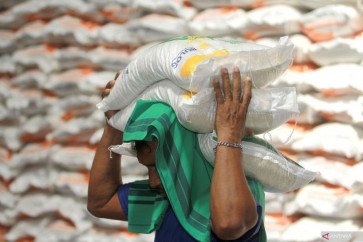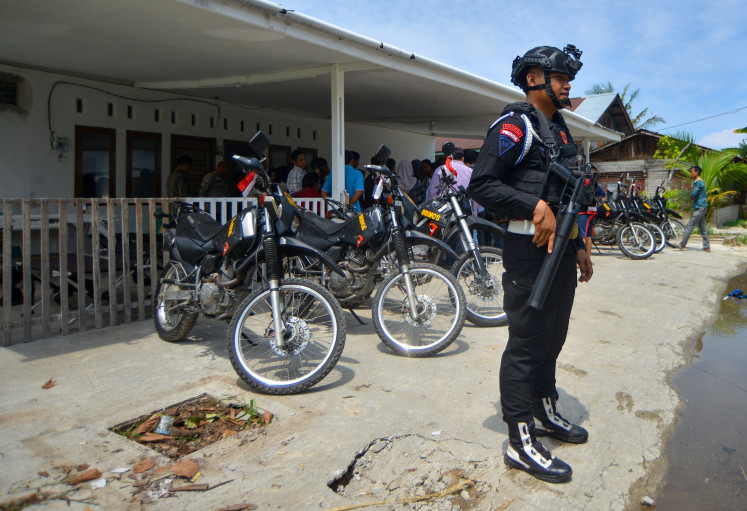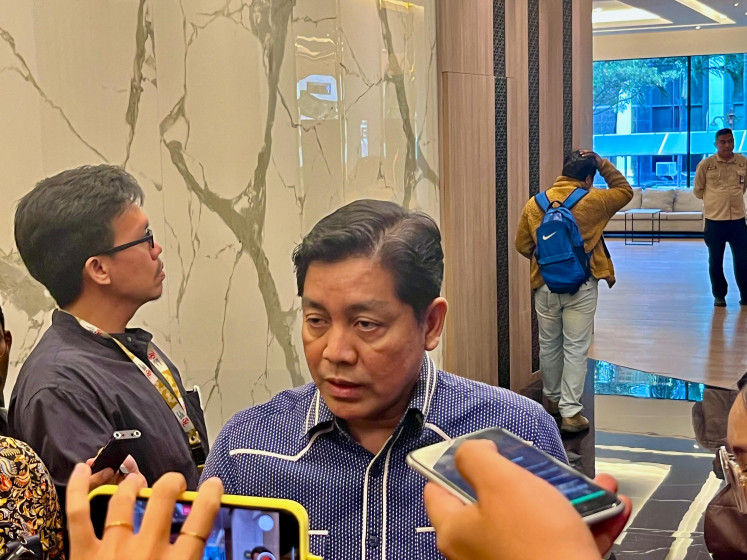Popular Reads
Top Results
Can't find what you're looking for?
View all search resultsPopular Reads
Top Results
Can't find what you're looking for?
View all search resultsGovernment lacks political will in developing railway network
During his visit to state-owned train manufacturer PT Industri Kereta Api’s (Inka) plant in Madiun, East Java, earlier this week, deputy transportation minister Bambang Susantono opened his remarks by reciting a story about the recent multi-billion-dollar acquisition of Burlington Northern Santa Fe (BNSF), one of America’s freight railway operators, by US billionaire and investment guru Warren Buffet
Change text size
Gift Premium Articles
to Anyone
D
uring his visit to state-owned train manufacturer PT Industri Kereta Api’s (Inka) plant in Madiun, East Java, earlier this week, deputy transportation minister Bambang Susantono opened his remarks by reciting a story about the recent multi-billion-dollar acquisition of Burlington Northern Santa Fe (BNSF), one of America’s freight railway operators, by US billionaire and investment guru Warren Buffet.
In front of the company’s board of directors, VIP guests and journalists, Bambang applauded Buffet for his visionary move in “anticipating the global trend shifting” from the use of road-based to rail-based transportation for accommodating the mobility of humans and goods following the rising fuel prices and unmanageable traffic congestion.
“Since our economy is now concentrated in a few major islands, like Java and Sumatra, Indonesia needs to develop not only its road infrastructure but also its railway transportation system to accommodate the mobility of bigger loads and more passengers at a relatively cheaper cost.” Bambang said.
“I believe this [rail-based transportation] will play an important role in enhancing our economy in the near future.”
Many analysts were surprised when Buffet, the world’s third-richest businessman according to Forbes magazine, made a US$26 billion deal to acquire BNSF in 2009. With more than 6,000 locomotives, the company transports, among others, coal, consumer goods and industrial material between US cities and to and from international ports, competing tightly with firms providing a similar service on the roads using trucks.
Buffet, however, called the deal “a bet on the country” as he predicted that rail-based transportation would be the backbone of the US’ economy in the next decades since it is more cost efficient and environmentally friendly than road-based transportation, which has been facing problems following the fluctuation of oil prices and the over-capacity of the road network.
Learning from Buffet’s experience and also from many countries which have successfully established reliable train services, like Japan, China and Taiwan; Indonesia, Southeast Asia’s largest economy, is currently eyeing revitalizing its railway network, in the hopes this will help citizens and business players reduce their heavy dependence on the country’s exhausted road network.
According to the government’s newly launched national economic corridors master plan for 2011 to 2025, Indonesia is now working to arrange a Rp 305.2-trillion ($35.4 billion) investment to improve the country’s rail-based transportation system, with Rp 222.2 trillion aimed at developing rail in Java, Rp 43.2 trillion in Sumatera and the remaining Rp 39.8 trillion in Kalimantan.
“The master plan has urged the railway operators in urban areas with existing rail tracks, like Jakarta, Yogyakarta, Bandung in West Java, Semarang in Central Java and Medan in North Sumatra, to improve their infrastructure and services first while the government is working on developing inter-city railway networks,” Bambang said.
The corridors are defined as six economic development highways, mostly located along coastlines, which would connect economic growth centers on five islands: Java, Sumatra, Kalimantan, Sulawesi and Papua.
As of 2008, Indonesian railway operator PT Kereta Api Indonesia (KAI) was operating 4,780 kilometers of rail tracks, with 72 percent of that located in Java and the remaining 28 percent in Sumatra. Under the master plan, the government is planning, for example, to double the railway route length in Java, which currently stands at 3,471 kilometers by 2030.
One of the most vital programs to improve rail transportation, according to Bambang, is the completion of the 780-kilometer double-track line connecting Jakarta to Surabaya, East Java, the second-largest city in the country, which is scheduled to be finished by 2014, and will cost the government around Rp 9 trillion.
“Once completed, the new track would help increase the volume [of goods] transported between Jakarta, the country’s busiest export-import center, and Surabaya, whose Tanjung Perak port is facilitating most of the [goods] shipping to the eastern part of Indonesia,” he added.
The history of railway in Indonesia dates back to the late 19th century when the Dutch colonial administration worked hand-in-hand with the private sector to develop rail tracks mainly to support their large-scale plantation businesses.
By 1939, the administration had successfully begun operating 6,811 kilometers of rail tracks in Indonesia. The number, however, fell to 5,910 kilometers several years later after the Japanese colonial administration transported some of the tracks to Myanmar.
Now, with a limited budget from the government to maintain and develop its aging infrastructure, the country’s railway operator has been struggling to survive “unfair” competition with road-based transportation, which has been heavily subsidized by the government.
This year, for example, the Transportation Ministry’s Directorate General of Railways received less than Rp 4 trillion to finance its development programs, much less than the Rp 28 trillion allocated by the government for the Public Works Ministry’s Directorate General of Bina Marga, which oversees the construction and maintenance of roads.
Given the limited budget support, coupled with pressure from the public who have been very sensitive to ticket price increases, it is no surprise that both the railway authority and operators have been facing problems in upgrading infrastructure and backbone facilities, including telecommunication and signaling systems, as a way to improve travel safety and service standards.
At the same time, PT KAI also must prepare to lose its monopoly on the industry following the issuance of the 2007 Railway Law, which allows the private sector to enter the industry.
Last year, PT KAI booked Rp 5.08 trillion in operating revenue, a 7.58 percent increase from Rp 4.7 trillion generated in 2009. Meanwhile, its net profit soared 140 percent from Rp 153.8 billion to Rp 216.3 billion.
Indonesian Democratic Party of Struggle member Nusyirwan Soedjono, a deputy chairman of House of Representatives’ Commission V overseeing transportation affairs, has long questioned the government’s reluctance to allocate more state funding for the improvement of the country’s railway network, blaming its submission to “high-level” political lobbying arranged by the automotive industry, which has received direct advantages from the rapid development of the country’s road infrastructure.
“There has been no story of us [the Commission V] rejecting the government’s budget proposal for developing railway infrastructure,” Nusyirwan told The Jakarta Post. “But it seems like there have been certain ‘powerful groups’ which always oppose every attempt to advance the services of our mass transportation, especially trains.”










